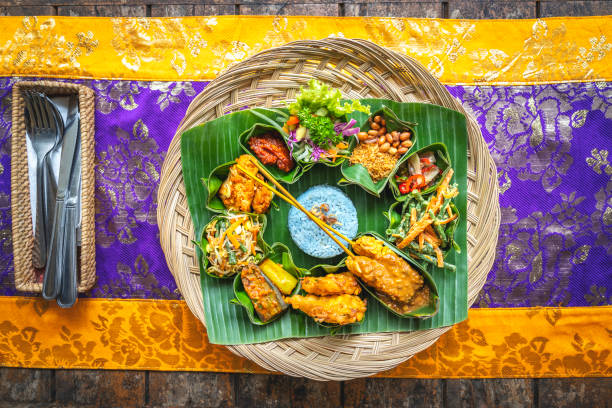The enchanting island of Indonesia, Bali, captivates with its rich culture, awe-inspiring landscapes, and, of course, its tantalizing cuisine. Balinese cuisine is a symphony of flavors, a harmonious blend of indigenous ingredients, and influences from neighboring countries. Embark on a culinary adventure with us as we delve into the heart of Balinese cooking, exploring the heritage ingredients that have shaped its unique identity.
The Essence of Balinese Cuisine
The island’s rich agricultural traditions deeply root Balinese cuisine. Bali’s fertile soil yields fragrant spices and vibrant fruits, enhancing its distinct culinary scene with abundant fresh produce. In Balinese cooking, chefs emphasize balance by carefully combining sweet, sour, salty, and spicy elements to create a symphony of flavors.
Aromatic Spices: The Soul of Balinese Cuisine
Spices are the soul of Balinese cuisine, infusing dishes with layers of complexity and depth. In Bali’s spice cabinet, aromatic gems abound, imparting distinct flavors to the island’s culinary masterpieces, a true treasure trove. Here are some of the most prominent spices that define Balinese cuisine:
- Basa gede: A staple in Balinese cooking, basa gede is a spice paste made from a blend of shallots, garlic, turmeric, galangal, ginger, and other spices. It forms the foundation of many Balinese dishes, adding a rich and savory flavor.
- Basa genep: Another essential spice paste, basa genep, is a fragrant blend of shallots, garlic, lemongrass, turmeric, ginger, and other spices. It is often used in curries and vegetable dishes, adding a touch of sweetness and aroma.
- Balinese 8-spice: This aromatic blend comprises white pepper, black pepper, coriander, cumin, clove, nutmeg, sesame seed, and candlenuts. It adds a warm and complex flavor to many Balinese dishes, particularly meat and seafood specialties.
Read More:
10 Essential Kitchen Gadgets for Every Cook
The Chinese Imprint on Southeast Asian Cuisine
Culinary Delights: A Taste of Balinese Heritage
The heritage ingredients of Bali come together to create a culinary landscape brimming with delectable dishes. Let’s explore some of the most iconic Balinese dishes that showcase the island’s culinary heritage:

- Satay Lilit: These delectable skewers feature minced meat, often chicken or fish, seasoned with a flavorful spice paste and wrapped in lemongrass leaves. Grilled to perfection, satay lilit is a symphony of textures and flavors.
- Lawar: This unique dish is a testament to Balinese resourcefulness, utilizing all parts of an animal, including meat, offal, and vegetables. Lawar is a labor of love, requiring meticulous preparation and resulting in a complex and flavorful dish.
- Betutu: This slow-cooked duck dish is a culinary masterpiece, marinated in a rich spice paste and wrapped in banana leaves. The result is a tender, flavorful duck that melts in your mouth.
- Sate Lilit: These bite-sized skewers feature minced meat, often chicken or fish, seasoned with a flavorful spice paste and wrapped in lemongrass leaves. Grilled to perfection, sate lilit is a symphony of textures and flavors.
- Jimbaran Bay Seafood: Jimbaran Bay is renowned for its fresh seafood grills, where you can select your catch and have it cooked to your liking. The seafood feast, accompanied by traditional Balinese sides, is a must-try experience.
A Culinary Journey to Remember
Balinese cuisine is a testament to the island’s rich heritage ingredients and vibrant culture. Each dish tells a story, a blend of tradition, innovation, and the island’s natural bounty. Exploring Bali’s culinary scene unveils a world of enticing flavors, textures, and aromas, leaving an indelible impression on your palate.
